I was planning to do inspiration posts for each Historical Sew Fortnightly Challenge in the fortnight running up to the challenge, but I realise that defeats the whole purpose of posting the challenges weeks ahead and giving people time to plan for the challenge. Instead I’ve decided to do inspiration posts when I announce the next challenge (a full 16 weeks ahead). Of course, first I have to catch up on all the challenges that are already up!
So, over the next few weeks expect lots of pretty, pretty historical eye candy inspiration posts.
Today I’m starting with some gorgeous stripes to get you inspired for the upcoming Historical Sew Fortnightly challenge: Stripes (#6), mostly because I already had the post written!
I think the important thing to remember about the Stripes challenge is that there are many ways to interpret stripes. Some people have bowed out of the challenge because they don’t like stripes, but I think that’s just silly. Stripes don’t need to be bold, big, black and white stripes. They can be as subtle as the tiny self-striped silk in the sleeves and bodice of my 1813 Kashmiri dress, as simple as a striped ’20s Chanel sailor top. They can be created with striped fabric, or by applying trim to create a striped effect.
The ancient Egyptians may not have gone in for patterned fabric, but their neighbors did. This mural shows Caananites in brightly patterned, including striped, tunics bringing tribute to Egypt.
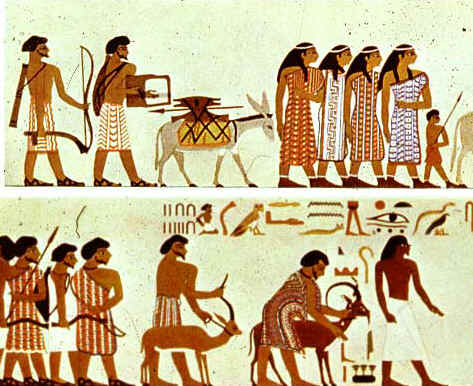
Skipping ahead a millennia, Parmigianino’s rosy cheeked young woman has both a fascinating striped headdress and what I think is a striped partlet -gorgeous and exotic.
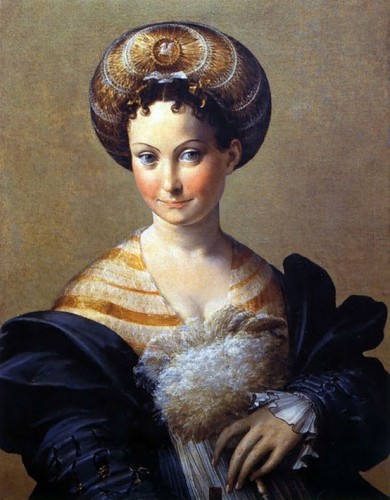
Parmigianino- A Turkish Slave (aka, Portrait of a Young Woman) ca. 1533
Now, how about some fabulous 17th century stripes going every-which way (and isn’t her dog just darling?)?
Or some sweet fancy dress stripes from the early 18th century?

ca. 1720 Henrietta Hobart, The Hon. Mrs Howard, later Countess of Suffolk, in a masquerade dress, attributed to Thomas Gibson, Blickling Hall – Blickling, North Norfolk UK
Rococo stripes are often paired with flowers arranged in the classic serpentine line, lending them an air of femininity and frivolity:
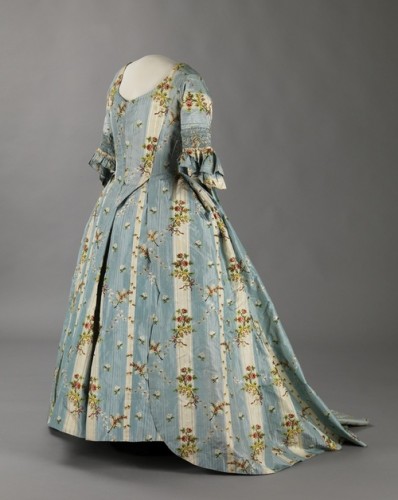
Robe a la francaise, ca. 1770’s, Digitalt Museum
At the end of the 18th century the serpentine line of rococo gave way to the stripes and white severity of Neoclassicism – this charming jacket is a midpoint between the two:
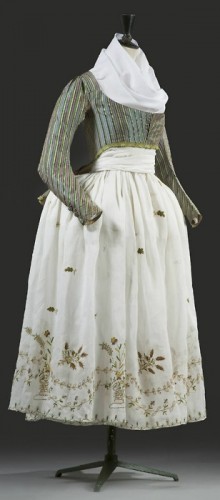
Striped jacket and embroidered skirt, late 18th century, Metropolitan Museum of Art
Another version of the Neoclassical stripe is seen on this late 18th century fashionista:
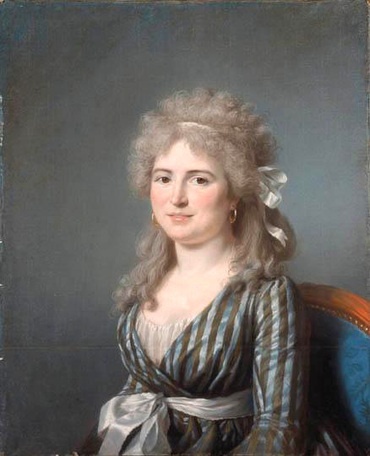
Portrait of a Portrait of Mme J L Germain , Marie-Gabrielle Capet, 1780s
Of course, not every striped item has to be a full frock. This bonnet with its trim stripes is just adorable:
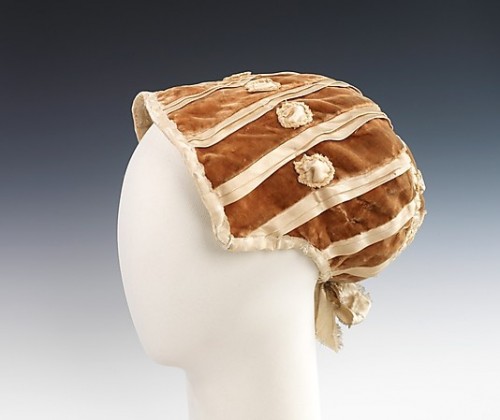
Bonnet, Evening, ca. 1802, American, silk, Metropolitan Museum of Art
Neoclassical stripes were soften with lace and trimmings as the 19th century progressed, but they are still quite bold and severe and striking in this frock:
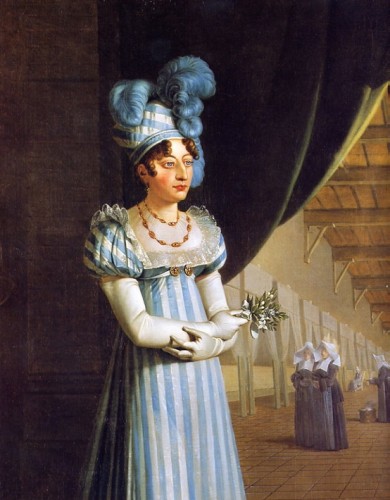
The Duchesse d’Angoulême and the Hospital at Toulouse by Joseph Roques, 1815 or later
I love the use of horizontal stripes in the mid-19th century. It really emphasizes the width of the hoopskirts.

Morning dress, 1860-65, silk, American, Metropolitan Museum of Art
And look how beautiful the arrangement of stripes on this bodice is:
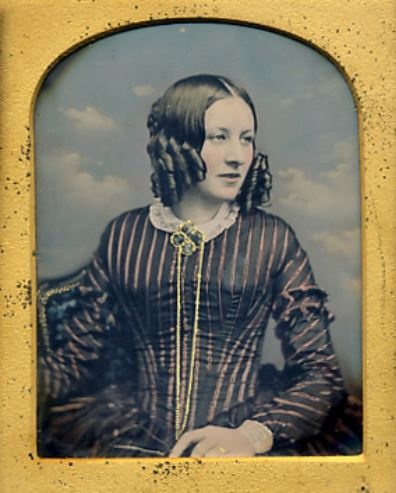
ca 1850’s hand-tinted daguerreotype portrait of a young woman posed in front of a cloud backdrop
The Victorians knew how to do stripes, using them to full effect in 1880s bustles. This frock manages to be both striking and subtle in its use of stripes:
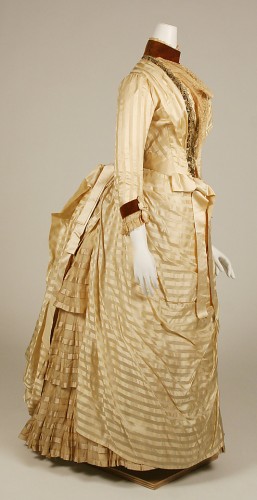
Dress, ca. 1886, American, silk, metallic thread, beads, Metropolitan Museum of Art
If that’s a little too subtle for you, perhaps this one is bold enough:

Evening Dress, Jacques Doucet, 1890s, The Mint Museum
For something a bit simpler, this teens jacket could easily be used in modern life, and the lavender dress cleverly creates its own stripes through the use of trim:

Day and sport dresses, 1916, US, the Delineator
These 20s swimsuits use very modern and restrained stripes – the tops could be worn as simple singlets today.
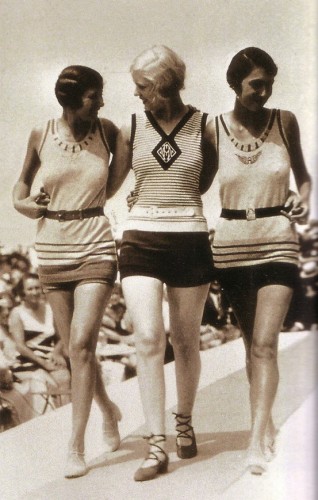
Swimsuits, 1928
What’s not to love about Hattie Carnegie’s amazing use of stripes in this ’30s ensemble. Tres chic!
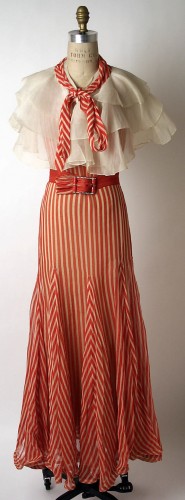
Striped evening ensemble (dress, belt, cape, slip) by Norman Norell for Hattie Carnegie, Inc., American, 1932, Metropolitan Museum of Art
Finally, something from the very last year of eligibility. These sandals are just fabulous, and I think they could be replicated with strips of suede and a pair of modern sandals with the right heel.
If that wasn’t enough striped inspiration for you, I have a whole pinterest page of striped loveliness to spark your imagination (just remember that the post 1938 stuff is not eligible for the HSF).



Yum! I will definitely be repinning some things! The headpiece in the second image is fascinating. What do you think it is made of? Woven straw?
Thank you so much for giving us an advance look at these ideas to fuel our imagination! I’m not especially fond of stripes myself, however I’m learning that there are some charming applications with them out there. I like some of the ideas here. Thanks!
Laurie
Wow! what a collection!
Woot for stripes! I think I’ve decided on a striped project for this challenge if I can find an appropriately striped fabric.
Happy sigh! Wonderful feasts for the eye – thank you!
These pictures are absolutely delicious. I’m kind of weird about stripes as sometimes I feel like they’re too ‘inmate’ looking. However, there are some stunning ideas in this collection of pictures and inspiration you’ve posted. I really love the chevron effect created by stripes more than anything…especially that biased 1930s skirt. Some of my favorite 1950s clothing involves playing with stripes to make chevrons, but doing the same thing with a hankerchief style skirt is brilliant.
It’s fabulous! I don’t need the inspiration, because I already have a plan, but there can never be too much historical yumminess for me. 😉
Oh, and I ran again into this favourite of yours
http://en.wikipedia.org/wiki/File:Juana_In%C3%A9s_de_la_Cruz.jpg which goes wonderfully for both striped and Flora. 😉
Funny, I actually ran into that myself, but the painting is actually from the ’80s, and I very much doubt how much they researched the costumes!
I was wondering a little bit about the costume myself… hmmm…
These are gorgeous! That black and white evening dress is amazing.
I’m considering a stripey muff, like this one.
http://damesalamode.tumblr.com/image/3644274898
It should be easier to make a muff out of recycled fur when you need two different colours in smaller amounts.
Ohhhhh